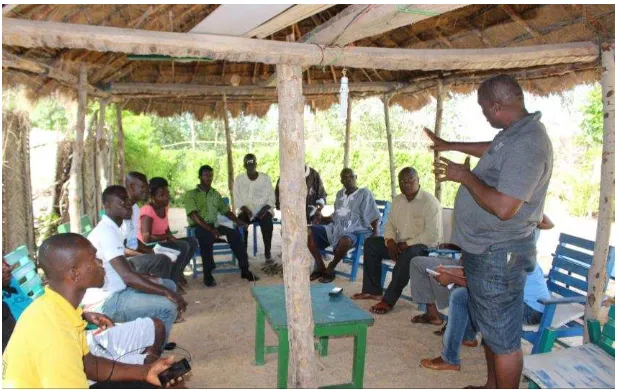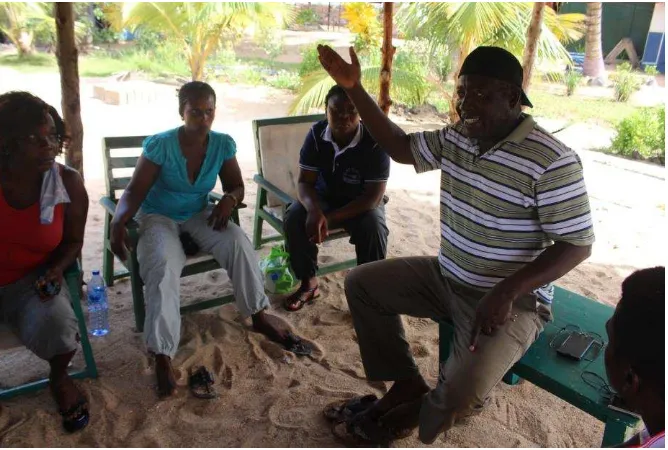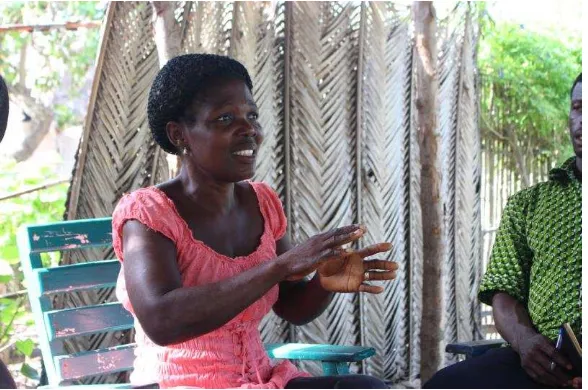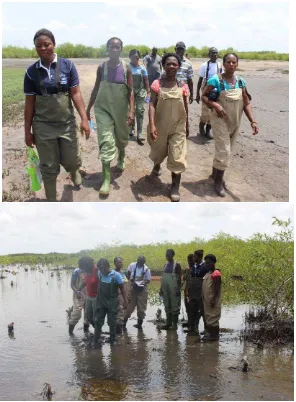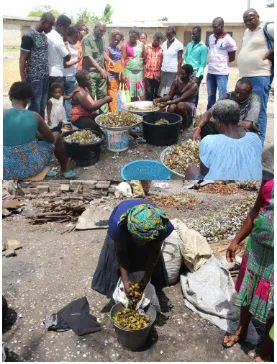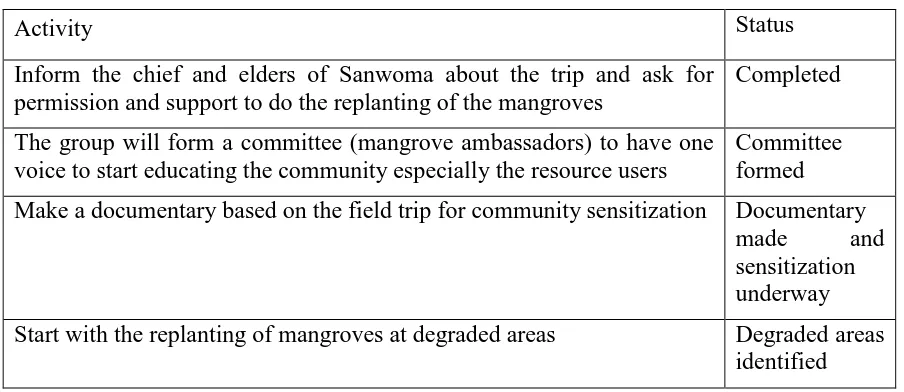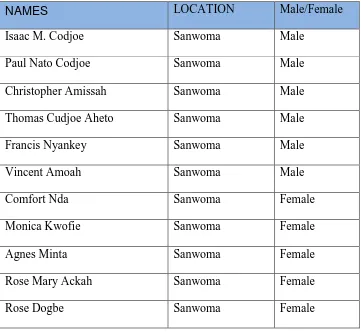SUSTAINABLE FISHERIES
MANAGEMENT PROJECT (SFMP)
STUDY TOUR TO THE VOLTA
REGION
This publication is available electronically on the Coastal Resources Center’s website at
http://www.crc.uri.edu/projects_page/ghanasfmp/
For more information on the Ghana Sustainable Fisheries Management Project, contact:
USAID/Ghana Sustainable Fisheries Management Project Coastal Resources Center
Graduate School of Oceanography University of Rhode Island
220 South Ferry Rd.
Narragansett, RI 02882 USA
Tel: 401-874-6224 Fax: 401-874-6920 Email: [email protected]
Citation: Doku, D., Owusu, A., Gormey, B. (2016). Lessons Learned on Volta Estuary Study Tour. USAID/Ghana Sustainable Fisheries Management Project (SFMP). Narragansett, RI: Coastal Resources Center, Graduate School of Oceanography, University of Rhode Island. GH2014_ACT053_HM. 15 pp.
Authority/Disclaimer:
Prepared for USAID/Ghana under Cooperative Agreement (AID-641-A-15-00001), awarded on October 22, 2014 to the University of Rhode Island, and entitled the USAID/Ghana Sustainable Fisheries Management Project (SFMP).
This document is made possible by the support of the American People through the United States Agency for International Development (USAID). The views expressed and opinions contained in this report are those of the SFMP team and are not intended as statements of policy of either USAID or the cooperating organizations. As such, the contents of this report are the sole responsibility of the SFMP team and do not necessarily reflect the views of USAID or the United States Government.
Detailed Partner Contact Information:
USAID/Ghana Sustainable Fisheries Management Project (SFMP) 10 Obodai St., Mempeasem, East Legon, Accra, Ghana
Telephone: +233 0302 542497 Fax: +233 0302 542498
Maurice Knight Chief of Party [email protected]
Kofi Agbogah Senior Fisheries Advisor [email protected] Nii Odenkey Abbey Communications Officer [email protected]
Bakari Nyari Monitoring and Evaluation Specialist [email protected] Brian Crawford Project Manager, CRC [email protected]
Justice Odoi USAID Administrative Officer Representative [email protected]
Kofi.Agbogah
SNV Netherlands Development Organisation #161, 10 Maseru Road,
E. Legon, Accra, Ghana 233 30 701 2440 Donkris Mevuta Kyei Yamoah
[email protected] Friends of the Nation Parks and Gardens Adiembra-Sekondi, Ghana 233 312 046 180
Peter Owusu Donkor Spatial Solutions
[email protected] #3 Third Nautical Close,
Nungua, Accra, Ghana
Darkuman Junction, Kaneshie Odokor Highway
Accra, Ghana 233 302 315894 Gifty Asmah
[email protected] Daasgift Quality Foundation
Headmaster residence, Sekondi College Sekondi, Western Region, Ghana 233 243 326 178
For additional information on partner activities:
CRC/URI: http://www.crc.uri.edu
CEWEFIA: http://cewefia.weebly.com/
DAA: http://womenthrive.org/development-action-association-daa Daasgift:
https://www.facebook.com/pages/Daasgift-Quality-Foundation-FNGO/135372649846101 Friends of the Nation: http://www.fonghana.org Hen Mpoano: http://www.henmpoano.org
SNV: http://www.snvworld.org/en/countries/ghana SSG Advisors: http://ssg-advisors.com/
ACRONYMS
CEWEFIA Central and Western Region Fishmongers andImprovement Association
CRC Coastal Resource Center
DAA Development Action Association DAASGIFT Daasgift Quality Foundation
FC Fisheries Commision
MOFAD Ministry of Fisheries and Aquaculture Development SFMP Sustainable Fisheries Management Project
SNV Netherlands Development Organization URI University of Rhode Island
TABLE OF CONTENTS
ACRONYMS --- iii
TABLE OF CONTENTS --- iv
LIST OF FIGURES --- v
LIST OF TABLES --- v
BACKGROUND --- 1
Study tour objectives --- 1
Communities Visited --- 1
History behind the mangrove business --- 1
Land ownership --- 2
Site visit to Anyanui: --- 2
QUESTIONS, ANSWERS AND COMMENTS --- 3
Site Visit to Bomingo: --- 4
Site Visit to Galo-Sota --- 5
Site Visit to Salo (Mangrove City) - --- 5
ACTION PLAN MEETING ON GOING FORWARD --- 6
Visit to the ada clamp harvesting site --- 6
ONGOING MANGROVE PROJECTS WITHIN THESE COMMUNITIES --- 7
LESSONS LEARNED --- 7
ANNEX 1: ACTION PLAN AND WAY FORWARD--- 8
LIST OF FIGURES
Figure 1: Mr. Gormey of Hen Mpoano explaining the purpose of the visit at Ayanui ______ 2 Figure 2: Mr. Kareem of the Wildlife briefing participants on the importance of mangroves _ 3 Figure 3: Madam Monica Kwofie from Sanwoma asking question during visit to Anyanui __ 4 Figure 4: Participants at Bomingo mangrove project site _____________________________ 5 Figure 5: Participants at Ada Clamp site _________________________________________ 6
LIST OF TABLES
BACKGROUND
The USAID-funded Ghana Sustainable Fisheries Management Project (USAID/SFMP) implemented by the University of Rhode Island works closely with the Ghana Ministry of Fisheries and Aquaculture Development (MOFAD), the Fisheries Commission (FC) and local and international partners to rebuild marine fisheries stocks and catches through adoption of responsible fishing practices. It aims to end overfishing of key stocks important to local food security.
The focus of the SFMP on the two key estuarine environment namely; the Ankobra and Pra estuaries in the Western and Central Region respectively, is because of the critical role they play in fishery, serving as a nursery ground for some key fish species particularly the demersal species.
Most of the natural resources within and along the Ankobra estuary face many challenges including over exploitation by people living along the estuary without any corresponding efforts aimed at management through regeneration. This unfortunate situation has contributed largely to depletion, loss of biodiversity, reduction in livelihood activities and increased level of poverty in these resource-dependent communities.
Little or no attempts have been made by both state and non-state actors to conserve the floral and faunal resource within the Ankobra estuary. This has led to a situation whereby these natural resources are exploited without any management regime put in place to ensure sustainability. Resources such as mangroves, bamboos, rattan and raffia are harvested on commercial scale, which will ultimately have a negative effect on fishery resources if the situation is not properly managed in conjunction with the communities involved.
As part of efforts by the SFMP to sustain these resources through a co-management
approach, a replanting activity at the Ankobra estuarine area has been scheduled, in other to sustain the efforts, there was the need for the people of Ankobra area to be able to see the need to manage and sustainably harvest these resources.
Against this background, members of the Ankobra community (Sanwoma) were selected to visit some mangrove growing communities within the Volta Region to learn some of the management sytems that exist within these communities.
Study tour objectives
The objectives of the study tour were to:
Expose participants to some of the different management systems practiced in the Region
To promote Co-management of resources at the Ankobra Communities Visited
Four mangrove growing communities were visited. These communities include Anyanui, Bomingo, Galo-Sota and Salo (Mangrove City). These communities are in the coastal district of Keta in the Volta Region. The whole Keta community has been designated as a ramser site, together with all its resources. The only major floral resource within these communities visited is the red mangroves, which are harvested for fuel wood.
The clam farming at Ada, which is on the opposite side of the Volta River, was also visited. History behind the mangrove business
flow of most of the water canals that fed into major water bodies where fishing activites were taking place were seized. The surrounding communities were cut from the regular supply of water; water was no longer fed into the surrounding wetlands to serve as a nursery ground for the fishes and subsequently collapsed the fishing activities. After this incident, most people resorted into mangrove replanting and harvesting. Faced with this major loss of livelihood, the community developed a management regime that has ensured continuous supply of wood through planned replanting. The harvesting of planted mangroves has since become a
livelihood option for many people in the area.
“I’ve been replanting mangroves since 1963” Peter Kwabla Ahiaboy
Land ownership
Most lands within the communities visited are family owned. The farmers go into agreement with the landowners and the piece of land is cultiviated with mangroves. Some portion of the mangrove is given to the land owners as a form of payment. The distribution arrangements differ from one community to the other. Ongoing mangrove projects in the area also have arrangements with the community. At Anyannui, farmers divide the replanted mangrove into two halves. Sometimes the landowner decides to sell back their portion to the farmer.
At Salo, it was found out that the farmers divide it into 3portions, where the farmer takes 2 and give 1 part to the landowner.
Site visit to Anyanui:
The mangrove growers and sellers at Anyanui were visited in the morning. They briefed the the study tour participants on how they started with the mangrove business, the benefits involved, the replanting process and some of the arrangements between the growers and the landowners. From the conversations, one major challenge that the mangrove growers face is the competition of the mangroves with a plant species called the Acrosticum. Shrimp
farming, which has recently been introduced to the area, is also destroying the lands. When the mangroves are cleared for the shrimp farming they become devastated and replanting of mangroves becomes very difficult.
Figure 2: Mr. Kareem of the Wildlife briefing participants on the importance of mangroves
There are also no byelaws governing the buffer zones and people have started harvesting at the edges. When they are maintained, they serve as a safe haven and nursery grounds for some fish speicies.
QUESTIONS, ANSWERS AND COMMENTS
There was a question and answer session. Some of the questions asked include:
Ques: When mangroves are replanted how long does it take before they are harvested?
Ans: This depends on the substrate they grow in. Those that are found at the banks/edges of the waters where the substrate is very fertile and muddy takes 7 years, but those that thrive in areas where the substrate is not that fertile takes about 10 – 15 years.
Ques: Do you apply fertilizer?
Ans: No
Ques: Where do you get the propagules for replanting?
Ans: Mangrove seedlings are collected when they are matured and fall on the ground; some fall right into the substrate. When that happens we only go in to space them out and also transfer some to places where they are not much.
Ques: Have you experienced any disesase that destroy these mangroves?
Ans: There is one major plant that competes with the mangrove for space that is the Acrosticum sp. These ferns are invasive, grow from the rhizome and compete with the mangroves. Also crabs feed on the seeds of the mangroves when they are initially planted. Ques: Does the water destroy the mangroves when they are flooded?
Ans: No they do not; they are flooded for about 6 hours and the water recede for about 6 hours
Ans: They are sold according to sizes. They bundle the main stems, the branches and the roots. The prize of the stem ranges between GHS 4.00 – 5.00 cedis, branches cost 3.00 cedis and the roots for 1.50 cedis.
Ques: How do you know the mangroves have reached maturity for cutting?
Ans: When the mangrove plants get seedlings and start falling into the substrate. That’s the only way to ensure continuity and sustainability. If the seeds don’t start falling to regenerate before you harvest you eventually run at a loss.
Figure 3: Madam Monica Kwofie from Sanwoma asking question during visit to Anyanui
Quote:
We just harvest mangroves at Ankobra without replanting, never thought or heard that mangroves can be replanted; I thought God himself makes them grow
Madam comfort Nda Sanwoma
Mangrove plants are very lucratic business you can venture
Paul Nato Codjoe, Sanwoma
Site Visit to Bomingo:
Figure 4: Participants at Bomingo mangrove project site
Site Visit to Galo-Sota
Early afternoon we set off from Bomingo to Anyanui by boat and from Anyannui to Galo-Sota. We visited some mangrove conservation site. The mangrove site visited is one of the SNV initiated mangrove conservation site for the community. About 21 hacters of land have been set-aside by individuals and families to be conserved for over 10 years before any harvesting can take place if necessary. In terms of sustaining the livelihood of the people, extra mangrove lands are available for harvesting and in addition, livestock rearing is being piloted in the Galo-Sota community.
The mangrove growers and sellers who are now into conservation briefed the study tour participants on how they started with the mangrove business and the benefits they derive from the mangroves.
Site Visit to Salo (Mangrove City) -
The chief and his elders also briefed the team on how the mangroves have a benefit to the Salo community.
From the conversations, one major challenge that the mangrove growers face is the competition of the mangroves with a plant species called the Acrosticum.
ACTION PLAN MEETING ON GOING FORWARD
The study tour participants met at the Hotel in the morning where they reflected on lessons learned, based on this an action plan was developed on the wayforward to help manage and sustain the Ankobra managrove resources.
Visit to the ada clamp harvesting site
On our way back to the Western Region, Participants had the chance to visit the Ada clamp harvesting site before heading back to Takoradi.
ONGOING MANGROVE PROJECTS WITHIN THESE COMMUNITIES
Some of the ongoing mangrove projects within the communities visited included the ATIDEV initiative, which started operations in 2012 and SNV sponsored project which started in 2014.
The ATIDEV initiative is working within 6 Communities, which include Dzita, Anyannui, Bomingo, Tunu, Galo-Sota and Salo. Four out of the 6 communities were visited.
The ATIDEV initiative together with the communities has replanted mangroves and gone into agreement with these communities not to cut until 15 years. After the 15-year period they can either decide to cut or sell them for carbon credit.
The SNV mangrove project is working at Galo-Sota. They went into agreement with farmers who have already planted their mangroves and have been able to convince them not to cut and maintain it as a forest for 10 years. This will help increase the biodiversity and reduce green house effect in the system. It is also an incentive to farmers, because bigger trees will fetch the farmers more money in the future. But the main aim of the SNV project is to ensure that after the 10-year period the people will come to realize the importance of conserving mangroves.
These projects have also introduced some livelihood options for farmers who have decided not to cut their mangroves. The livelihood options include Bee keeping, Grass Cutter rearing, value addition to mat weaving, mango planting, sheep and goat rearing and Fish farming. Lands have also been demarcated for woodlot.
Land owners also receive benefits based on the agreement they have with the farmers. There is also a portion that goes to the community.
LESSONS LEARNED
Study tour participants got to know that mangroves could be replanted.
Differents techniques of replanting based on the purpose for the planting were also learned.
Participants were motivated to start replanting degraded site based on what they heared and saw on the field.
Land ownership among communities visited were different from land ownewrs of Sanwoma (Ankobra)
ANNEX 1: ACTION PLAN AND WAY FORWARD
Table 1 Action Plan and Wayforward
Activity Status
Inform the chief and elders of Sanwoma about the trip and ask for permission and support to do the replanting of the mangroves
Completed The group will form a committee (mangrove ambassadors) to have one
voice to start educating the community especially the resource users
Committee formed Make a documentary based on the field trip for community sensitization Documentary
made and sensitization underway Start with the replanting of mangroves at degraded areas Degraded areas
ANNEX 2: PARTICIPANT LIST
Table 2 Participant List
NAMES LOCATION Male/Female
Isaac M. Codjoe Sanwoma Male
Paul Nato Codjoe Sanwoma Male
Christopher Amissah Sanwoma Male
Thomas Cudjoe Aheto Sanwoma Male
Francis Nyankey Sanwoma Male
Vincent Amoah Sanwoma Male
Comfort Nda Sanwoma Female
Monica Kwofie Sanwoma Female
Agnes Minta Sanwoma Female
Rose Mary Ackah Sanwoma Female
